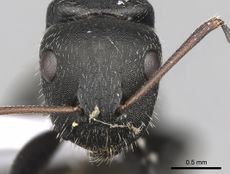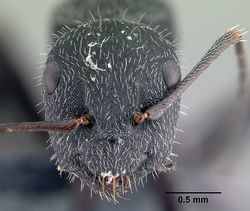Key to Camponotus kiesenwetteri species group
This worker key is based on: Salata, S., Loss, A.C., Karaman, C., Kiran, K., Borowiec, L. 2019. Review of the Camponotus kiesenwetteri group (Hymenoptera, Formicidae) in the Aegean with the description of a new species. ZooKeys 899: 85–107 (doi:10.3897/zookeys.899.46933).
Species of the Camponotus kiesenwetteri group (subgenus Myrmentoma) are primarily found in areas adjacent to the Aegean Sea, i.e., mainland Greece, Crete and other islands, and western Turkey. The range of some species collectively extend the group's range further east (including Cyprus, Lebanon, northern Israel, Iran, and other parts of Turkey) and north (including North Macedonia and Bulgaria).
You may also be interested in
1
- Mesosoma in lateral view forms a regular arch; metanotal groove absent . . . . . 2
- Mesosoma in lateral view with shallow metanotal groove . . . . . 4
2
return to couplet #1
- Legs mostly yellowish to reddish-brown, gaster yellowish-brown. Setation of head, mesosoma, and gaster short and sparse. Eastern, western and central Turkey . . . . . Camponotus aktaci
- Legs and gaster mostly brown to black. Setation of head, mesosoma, and gaster long and dense . . . . . 3
3
return to couplet #2
- Petiolar scale thin, PI > 1.50. Northeastern Greece, Eastern Aegean Islands and western Turkey . . . . . Camponotus aegaeus
- Petiolar scale thick, PI < 1.42. The Middle East . . . . . Camponotus libanicus
4
return to couplet #1
- Posterior margin of propodeum with well developed, lateral dentate protrusions. Base of antennal scape with extension. Northeastern, eastern and southern Greece and western Turkey . . . . . Camponotus kiesenwetteri
- Posterior margin of propodeum without or with weakly developed, indistinct protrusions. Base of antennal scape without or with indistinct extension . . . . . 5
5
return to couplet #4
- Surface of mesosoma more strongly sculptured, reticulate and granulate with more or less dull background; posterior margin of propodeum sometimes with weakly-developed, indistinct protrusion (Figs 11, 12). Base of antennal scape without extension. Peloponnese, Crete, southern and eastern Aegean islands and western Turkey . . . . . Camponotus boghossiani
- Surface of mesosoma weaker sculptured, especially sides of mesosoma appear more or less shiny; posterior margin of propodeum without protrusions. Base of antennal scape with or without extension . . . . . 6
6
return to couplet #5
- Base of antennal scape with extension (Fig. 3). Petiolar scale thick, PI: 1.26–1.33. Western Turkey . . . . . Camponotus schulzi
- Base of antennal scape without extension (Fig. 4). Petiolar scale thin, PI: 1.54– 1.74. Cephalonia Island, western Sterea Ellas and Peloponnese . . . . . Camponotus nitidescens














